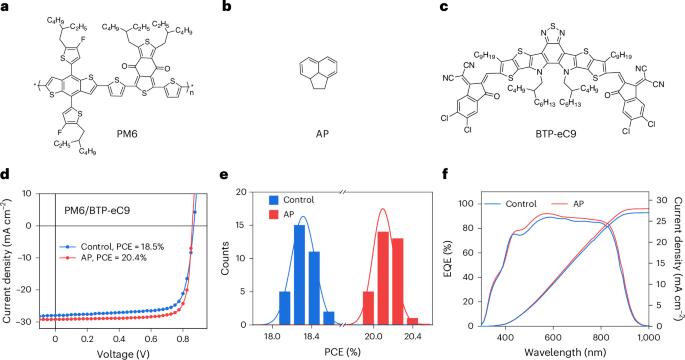Two-step crystallization modulated through acenaphthene enabling 21% binary organic solar cells and 83.2% fill factor
IF 60.1
1区 材料科学
Q1 ENERGY & FUELS
引用次数: 0
Abstract
The crystallization dynamics of non-fullerene acceptors influences the morphology and charge dynamics of the resulting organic solar cells, ultimately determining device performance. However, optimizing the molecular arrangement of donor and acceptor materials within the active layer remains challenging. Here we control the crystallization kinetics of non-fullerene acceptors with a crystallization-regulating agent, acenaphthene. Acenaphthene changes the self-organization of acceptor molecules by inducing a two-step crystallization: it first fixes the packing motif of the acceptor and then refines the crystallized framework, leading to highly oriented acceptors in the active layer. This forms several charge-transport pathways that improve the charge-transport properties of the device. As a result, efficiencies of 20.9% (20.4% certified) and 21% (20.5% certified) are achieved in D18/L8-BO and PM1/L8-BO-X binary organic solar cells, respectively, with a maximum fill factor of 83.2% (82.2% certified). The result is a step forward in the development of organic solar cells. Optimizing the crystallization of the active materials in organic solar cells is challenging. Fu et al. use an acenaphthene additive to induce a two-step crystallization of the non-fullerene acceptor, achieving a certified 20.5% power conversion efficiency.

通过苊调制的两步结晶可实现21%的二元有机太阳能电池和83.2%的填充因子
非富勒烯受体的结晶动力学影响所得有机太阳能电池的形态和电荷动力学,最终决定器件性能。然而,优化活性层内供体和受体材料的分子排列仍然具有挑战性。在这里,我们用一种结晶调节剂苊来控制非富勒烯受体的结晶动力学。苊通过诱导两步结晶来改变受体分子的自组织:首先固定受体的包装基序,然后细化结晶框架,导致活性层中高度定向的受体。这形成了几种电荷传输途径,改善了器件的电荷传输特性。结果,D18/L8-BO和PM1/L8-BO- x二元有机太阳能电池的效率分别达到20.9%(认证20.4%)和21%(认证20.5%),最大填充系数为83.2%(认证82.2%)。结果是有机太阳能电池的发展向前迈进了一步。优化有机太阳能电池中活性材料的结晶是一项具有挑战性的工作。Fu等人使用苊添加剂诱导非富勒烯受体的两步结晶,获得了经认证的20.5%的功率转换效率。
本文章由计算机程序翻译,如有差异,请以英文原文为准。
求助全文
约1分钟内获得全文
求助全文
来源期刊

Nature Energy
Energy-Energy Engineering and Power Technology
CiteScore
75.10
自引率
1.10%
发文量
193
期刊介绍:
Nature Energy is a monthly, online-only journal committed to showcasing the most impactful research on energy, covering everything from its generation and distribution to the societal implications of energy technologies and policies.
With a focus on exploring all facets of the ongoing energy discourse, Nature Energy delves into topics such as energy generation, storage, distribution, management, and the societal impacts of energy technologies and policies. Emphasizing studies that push the boundaries of knowledge and contribute to the development of next-generation solutions, the journal serves as a platform for the exchange of ideas among stakeholders at the forefront of the energy sector.
Maintaining the hallmark standards of the Nature brand, Nature Energy boasts a dedicated team of professional editors, a rigorous peer-review process, meticulous copy-editing and production, rapid publication times, and editorial independence.
In addition to original research articles, Nature Energy also publishes a range of content types, including Comments, Perspectives, Reviews, News & Views, Features, and Correspondence, covering a diverse array of disciplines relevant to the field of energy.
 求助内容:
求助内容: 应助结果提醒方式:
应助结果提醒方式:


